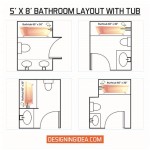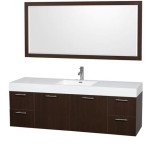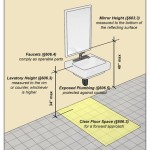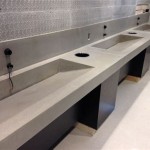12 Inch Depth Bathroom Sinks: Space-Saving Solutions for Compact Bathrooms
Optimizing space is a crucial consideration in modern bathroom design, particularly in smaller bathrooms, powder rooms, or en-suite areas with limited square footage. Standard bathroom sinks can occupy a significant amount of space, making movement and functionality challenging. One effective solution for addressing this issue involves implementing a 12-inch depth bathroom sink. This article explores the features, advantages, selection criteria, and installation considerations associated with these space-saving fixtures.
A 12-inch depth bathroom sink, as the name suggests, measures approximately 12 inches from the front edge to the back edge. This reduced depth compared to standard sinks (which typically range from 16 to 22 inches) allows for more floor space and improved maneuverability within the bathroom. These sinks are available in a variety of styles, materials, and mounting options, providing design flexibility while addressing spatial limitations.
Benefits of Utilizing 12-Inch Depth Bathroom Sinks
The primary benefit of a 12-inch depth bathroom sink is its space-saving capability. In small bathrooms where every inch matters, reducing the sink's footprint allows for easier movement, more storage options, and a less cluttered appearance. This is particularly important in powder rooms where the primary function is handwashing and the available space is often restricted.
Beyond space optimization, these sinks can also contribute to the aesthetic appeal of a bathroom. Their compact design can create a more streamlined and modern look, especially when paired with minimalist vanities and fixtures. They are also well-suited for wall-mounted installations, which further enhance the feeling of spaciousness by exposing more of the floor.
Furthermore, a 12-inch depth sink can be a practical choice for individuals with limited mobility. The reduced depth makes it easier to reach the faucet and basin, improving accessibility and usability. This is a significant advantage for elderly individuals or those with physical limitations who may find standard-depth sinks challenging to use.
Factors to Consider When Selecting a 12-Inch Depth Bathroom Sink
Choosing the right 12-inch depth bathroom sink requires careful consideration of several factors, including the sink's material, style, mounting type, and compatibility with existing plumbing. The material of the sink affects its durability, maintenance requirements, and overall aesthetic.
Common materials for bathroom sinks include vitreous china, porcelain, ceramic, glass, stainless steel, and natural stone. Vitreous china and porcelain are popular choices due to their durability, stain resistance, and ease of cleaning. Ceramic offers similar benefits and is often available in a wider range of colors and styles. Glass sinks provide a unique and modern aesthetic but may require more frequent cleaning to prevent water spots and mineral buildup. Stainless steel sinks are durable and hygienic but can be prone to scratches and dents. Natural stone sinks, such as granite or marble, offer a luxurious look but require sealing and special care to prevent staining and etching.
The style of the sink should complement the overall design of the bathroom. Common styles include vessel sinks, undermount sinks, drop-in sinks, and wall-mounted sinks. Vessel sinks sit on top of the countertop, creating a striking visual statement. Undermount sinks are installed beneath the countertop, providing a seamless and easy-to-clean surface. Drop-in sinks are installed into a pre-cut hole in the countertop, offering a relatively simple installation process. Wall-mounted sinks are attached directly to the wall, freeing up floor space and creating a modern, minimalist look.
The mounting type of the sink is closely related to its style and affects the installation process and overall functionality. Wall-mounted sinks require sturdy wall support and may necessitate relocating plumbing connections. Undermount sinks require a custom-cut countertop and professional installation. Drop-in sinks are generally easier to install but may not offer the same sleek aesthetic as undermount or wall-mounted options.
Finally, it is crucial to ensure that the chosen sink is compatible with the existing plumbing connections. The drain location and faucet configuration should align with the existing plumbing lines to avoid costly and complex modifications. It is also important to consider the faucet height and reach to ensure that it is appropriate for the sink's depth and style.
Installation Considerations for 12-Inch Depth Bathroom Sinks
The installation of a 12-inch depth bathroom sink depends on the chosen mounting type and the existing bathroom infrastructure. Wall-mounted sinks require careful planning and execution to ensure proper support and stability. The wall must be strong enough to bear the weight of the sink and any associated fixtures. It may be necessary to reinforce the wall with additional framing or support brackets.
Undermount sinks require a precisely cut countertop opening to ensure a seamless fit. It is recommended to have a professional fabricator create the countertop opening to avoid chipping or damage. The sink is then attached to the underside of the countertop using adhesive and mounting clips.
Drop-in sinks are generally easier to install, but it is still important to ensure a proper fit and seal. The sink is placed into the pre-cut hole in the countertop, and sealant is applied around the edges to prevent water leakage. The sink is then secured to the countertop using mounting clips or screws.
Regardless of the mounting type, it is essential to connect the drain and water supply lines properly. Use plumber's tape or pipe dope to seal the threaded connections and prevent leaks. Tighten the connections securely but avoid over-tightening, which can damage the fittings. After installation, thoroughly test the sink for leaks and ensure that the drain is functioning properly.
Furthermore, consider the placement of the sink in relation to other bathroom fixtures and features. Ensure that there is adequate clearance around the sink for comfortable use. Avoid placing the sink too close to the toilet or shower, as this can create a cramped and uncomfortable environment. Properly planning sink placement is critical for the overall functionality of the bathroom.
When installing a 12-inch depth bathroom sink, compliance with local building codes and plumbing regulations is paramount. These codes dictate the minimum clearances, drainage requirements, and water supply specifications for bathroom fixtures. Failure to comply with these codes can result in fines, delays, and potential safety hazards.
Before commencing any installation work, consult with a qualified plumber or building inspector to ensure that the proposed installation plan meets all applicable codes and regulations. This is especially important for wall-mounted sinks, which may require additional structural support to comply with safety standards. Furthermore, properly grounding any electrical connections associated with the sink area is essential to prevent electrical shock hazards.
Maintaining accessibility standards, particularly those outlined in the Americans with Disabilities Act (ADA), is essential when installing a 12-inch depth bathroom sink. The ADA provides guidelines for accessible design, including minimum clearances, reach ranges, and mounting heights for bathroom fixtures. Adhering to these guidelines ensures that the bathroom is usable by individuals with disabilities.
For example, the ADA specifies a maximum height for the sink rim and requires adequate knee clearance beneath the sink for wheelchair users. Additionally, the faucet controls should be easy to operate with one hand and require minimal force. Consulting the ADA guidelines and working with a certified accessibility specialist can help ensure that the bathroom meets accessibility requirements.
The long-term maintenance of a 12-inch depth bathroom sink is crucial for preserving its appearance and functionality. Regular cleaning is essential to prevent the buildup of soap scum, mineral deposits, and stains. Use a non-abrasive cleaner and a soft cloth or sponge to clean the sink surface. Avoid using harsh chemicals or abrasive scrubbers, as these can damage the finish.
Periodically inspect the drain and faucet for leaks or clogs. Clean the drain stopper regularly to remove hair and debris. If the faucet is dripping, repair or replace the worn-out parts. Addressing minor issues promptly can prevent them from escalating into more serious problems.
Protecting the sink from physical damage is also important. Avoid dropping heavy objects into the sink, as this can cause cracks or chips. Use a sink protector or basin mat to cushion the impact. For natural stone sinks, apply a sealant periodically to protect the surface from staining and etching.
Choosing a 12-inch depth bathroom sink involves a careful balance of aesthetic considerations, functional requirements, and spatial constraints. Thoroughly evaluate the available space, the existing plumbing infrastructure, and the overall design of the bathroom before making a decision. By carefully considering these factors, a 12-inch depth sink can transform a cramped bathroom into a stylish and functional space.

12 Inch Deep Bathroom Vanity Home Depot Combo

Home Decorators Collection Arvesen 18 In W X 12 D 34 H Single Sink Bath Vanity White With Ceramic Top 18w The Depot

12 Inch Deep Bathroom Vanity Floor Stand Cabinet Double Sink Solid Wood Overlay China Mirror Medicine Made In Com

Narrow Depth Bathroom Vanities Signature Hardware

The Best Shallow Depth Vanities For Your Bathroom Trubuild Construction
The 12 Inch Deep Upper Bathroom Cabinet Include One In Your Next Remodel Designed

Narrow Depth Bathroom Vanities Signature Hardware

22 Inch Narrow Depth Console Bath Vanity Custom Options Small Bathroom Sinks Vanities Sink

6 Space Saving Vanities For Small Bathrooms Unique

17 9 Inch Modern Console Small Bath Vanity With Sink
Related Posts







